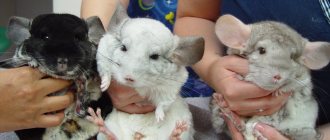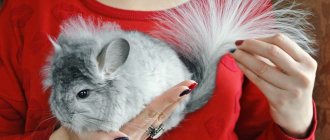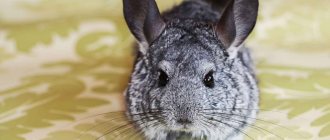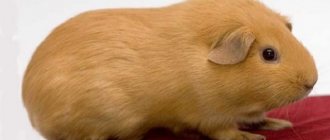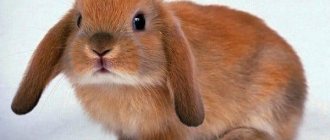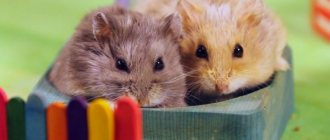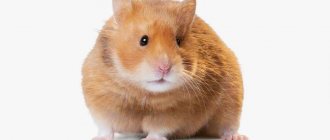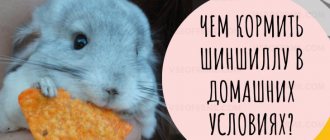Review author: “ZooVita”
The popularity of chinchillas as pets today is due solely to chinchillas themselves, which by their very nature have made people take a second look and notice the personality under the fur.
Thanks to their own merits, chinchillas have won human affection and respect. These furry animals have crossed the line from a commodity for fur production to a beloved pet.
And this will be fair, because this type of pet has been popular since 1920, and has become especially famous over the past 15 years. We are sure that after meeting them, you will be fascinated by their beauty. And the selection of photos of chinchillas will not allow you to doubt this!
General information about the domestic chinchilla
- Lifespan: up to 20 years in zoos
- Pregnancy: 111 days
- Birth number: 1 to 6, average 2
- Birth weight: 113 to 170 grams
- Maturity age: about 8 months
- Size Body length: from 220 to 240 millimeters; tail from 140 to 170 millimeters
- Weight: from 453 to 907 grams
Origin of the chinchilla
The domestic chinchilla is a nocturnal rodent native to the Andes. They belong to the Chinchillidae family and live exclusively in captivity.
It is a cross between Chinchilla Lanigera and Chinchilla Brevicaudata. They have been bred in captivity since 1923 and were selected for their thick, silky fur. Over the past 15 years, the chinchilla has become a popular household pet.
Appearance of a domestic chinchilla
Fast and fluffy is the most accurate and truthful description of this animal. The chinchilla is related to guinea pigs and porcupines.
With short front legs (which are used to hold food while sitting upright) and long, muscular hind legs, this rodent resembles the long-eared chinchilla rabbits.
Chinchilla hair is about 40 millimeters long with gray, white and black stripes. It may appear bluish or silvery gray. These creatures are fleet-footed. The chinchilla may look bulky, but behind its thick, silky fur hides the physique of an amazingly athletic rodent!
Large black eyes look at the ground and his bushy tail twitches. The short front feet have five toes, and the narrow hind feet have three toes and a vestigial toe with stiff bristles surrounding a small, flat claw. The bristles can help provide traction on any surface. Females are larger than males.
Having a thick coat and not being able to sweat, chinchillas can easily overheat in captivity. Its only cooling mechanism is to pump blood through its large ears, which have less hair.
Animals with beige color
Beige chinchilla (pastel) may have variations in shades. The older the animal, the darker its coat will be. It can be red, beige, brown. Animals are allowed to crossbreed.
Beige homozygous
Homobeige rodents with uniformly colored light beige fur have pink ears. The fur has no shading zoning; single hairs with dark “tops” are acceptable.
Heterobeige
Heterobeige, on the contrary, has uneven color. The entire fur is beige, and the undercoat and ends of the hairs are dark brown.
A heterobeige chinchilla with yellowness indicates a deterioration in breed qualities.
When choosing an animal, you must definitely consider the color line between the belly and the rest of the body.
Beige Tower
An animal with a coat color ranging from light to dark beige in combination with a brown ornament on the back looks intriguing.
Wellman's beige
A gentle little animal with light beige fur, delicate light ears and, as a contrast, black beady eyes.
Sullivan's Beige
The rodents that bear such a beautiful name have a rich beige coat and red eyes.
Brown velvet
These types of chinchillas have beige fur as a base, and their back and head are chocolate. The abdomen is sand-colored, sometimes almost white.
Ebony breed
The main difference between this chinchilla breed is not the color, but the quality of the fur. It shines extraordinarily and shimmers in the light. The color palette can be varied.
Homoebony
Black ebony is a rare type of color. The animals have a coal-black coat and black eyes. The second name for animals is charcoal.
Heteroebony
The shiny dark coat of heteroebony rodents combines two palettes: black and gray. Both options are great and eye-catching at exhibitions.
White ebony
There are chinchillas with a shining snow-white coat, which is given a special charm by black coating at the ends of the hairs. The paws, head and beginning of the tail can be gray or beige.
Physical characteristics of a chinchilla
The male chinchilla's body is slightly smaller, although the difference may not be immediately noticeable to the naked eye. They have a squat body and no markings on their heads.
Their length is from 20 to 35 cm, not counting the tail, which itself can reach 20 cm. An adult chinchilla will weigh from 400 to 800 g. They have a thick and bushy tail, the length of which varies.
They have thick fur all over their body, the color of which can vary. Their fur is one of the thickest on the planet.
The head may be larger or smaller depending on their genetic background. They have large round ears about 6 cm in diameter and are almost hairless. Their eyes, as befits nocturnal animals, are large and round, usually black or red depending on mutations and albinism.
Chinchilla family
In this family of six species, three species of wild chinchillas are now distinguished. Now let's talk about each type in more detail and in order.
Royal chinchilla
In Latin: king of the chinchillas. This particular species was once called the chinchilla, and lived in the highlands of the Andes, in many South American countries, at altitudes of over 4,000 meters above sea level. The king chinchilla was the largest of all chinchilla species studied.
The body of the royal chinchilla was about 47 centimeters in length. The ears were larger and more rounded, and the tail was up to 8 centimeters. The royal chinchilla's tail seemed even longer because the tail was covered with long fur. Not only did the royal chinchilla's tail have long fur, but the entire body of this animal was covered with long fur of different colors.
Beginning in the 1500s, Spanish colonists hunted these wild chinchillas for their unusually thick and soft fur, and by 1800 the animals were no longer found in the wild. Today, only the stuffed royal chinchilla remains in the German Museum in Frankfurt am Main.
Short-tailed chinchilla
This is also called the large chinchilla. In Latin: chinchilla chinchilla. Formerly known as Chinchilla Brevicaudata. This type of chinchilla is the largest species and these animals can be found in mountainous areas. These chinchillas have a more rounded and massive body, gray thick fur and a short tail. Short-tailed chinchillas are known for their changeable temperament - they are very docile and affectionate.
Female short-tailed chinchillas bear their young a little longer than their long-tailed counterparts. Pregnancy in a short-tailed chinchilla lasts about 130 days. Female short-tailed chinchillas are less fertile than long-tailed chinchillas and give birth to one or two young.
Previously, this species inhabited almost the entire southern part of South America. Currently, the species is known only from a few individuals caught in 2001, and from observations made in 2011 in the National Park.
To this day, two species of chinchillas have survived in nature. These two species are sometimes very difficult to distinguish, as they share the characteristics of both species of short-tailed chinchillas. Much of the mixing of species is due to the domestication of these animals.
Long-tailed chinchilla
It is also called the small or regular chinchilla. In Latin, Chinchilla lanigera is the common chinchilla. Other names include coastal chinchilla or long-tailed little chinchilla, a species of rodent belonging to the chinchilla family. He is better known as our family pet.
Long-tailed and short-tailed chinchillas were once widespread in the wild along the central Andes and surrounding mountains. The ban on chinchilla hunting in 1929, unfortunately, only increased the demand for pelts. The long-tailed chinchilla was thought to be extinct in the wild, but was rediscovered in 1975.
Today, there are a few scattered colonies of long-tailed chinchillas in two separate locations, in northern and central Chile, although legislation to protect chinchillas dates back to 1929. Unfortunately, this law was not strictly enforced until 1983, when the Chinchilla National Refuge was created.
Personality of the domestic chinchilla
Chinchilla is a nocturnal animal. They will be more active at night and will therefore need a quiet place to spend the day. They are timid, like animals, but they still need to be socialized. They are sensitive to stress and enjoy their routine, so they do not like changes in their environment, such as moving for the holidays.
Territorially speaking, they will not enjoy the company of other chinchillas unless they are raised together. Do not mix male and female chinchillas as breeding is difficult for them.
Diet for a pet chinchilla (instructions)
The issue of chinchilla nutrition is important, if not the main one. This factor affects the health and behavior of your pet. From birth, the diet is carefully selected and gradually regulated. Therefore, we will consider in great detail what to feed a chinchilla in order to avoid mistakes.
Constant access to clean drinking water from a drinking bottle, checked twice a day. Without water, chinchillas can become seriously ill.
Good quality hay should form the majority of their diet and should be available at all times. A hay rack is a good way to access food. The chinchilla's digestive system requires hay and grass to function properly. Chinchillas naturally feed on grasses, leaves and twigs.
Chinchillas' teeth constantly grow throughout their lives, needing to be worn down and maintained at the correct length and shape by eating grass, hay, and grass-based pellets. Failure to follow a proper diet can lead to serious dental problems.
Offer a small amount (1-2 tablespoons per chinchilla) of grass-based pellets daily in addition to hay. They eat by sitting on their hind legs and holding food in their front legs. Chinchillas naturally eat for long periods of time, mostly at night.
Give your chinchillas only small amounts of dried fruits and root vegetables as treats. You can also give them assorted dried herbs and plantain. Avoid nuts and seeds as they are high in fat.
If they eat too much of the wrong foods, such as grains, fruits, sweets, they may become overweight, sick, and suffer. If the correct diet is always available, chinchillas will usually maintain the correct weight.
Avoid sudden changes in diet as this may lead to digestive problems and serious illness.
Monitor the amount and types of food your chinchilla eats and how much they drink.
If your chinchilla's eating or drinking habits change or the number or size of the litter becomes smaller, contact your veterinarian immediately as they may become seriously ill. How much a chinchilla needs to eat depends on their age, lifestyle and health.
Chinchillas produce two types of droppings: hard, dry pellets and softer, wet pellets, which they eat right off the bottom and are an important part of their diet.
How to name
Your pet's appearance will help you choose a name for it.
Fans of these animals have a common affectionate name for chinchillas - Shunya or Shunka. Most often, when choosing a nickname, they are guided by the features of the animal’s appearance: coat color, location of spots, tail length. Popular names:
- Coal;
- Shadow;
- Smoke;
- Black;
- Marshmallow;
- Jasmine;
- Snezhanna;
- Samson;
- Bunny.
Keeping and breeding chinchillas at home is not troublesome or expensive. It will bring many joyful moments from communicating with animals and profit from the sale of offspring.
Chinchilla health and care (rules)
Chinchillas are quite fragile creatures. They may faint if they get scared, and an injured chinchilla will remain stressed for life. They are also prone to depression.
Don't be afraid to let them out of their cage, but it is important to remember that they are very sensitive to drafts, heat, direct sunlight and other sudden changes in temperature.
Chinchilla diseases
There are several diseases that chinchillas are susceptible to:
- Malocclusion (misaligned teeth)
- Toxemia (blood poisoning)
- Scurvy (vitamin C deficiency)
- Digestive problems
- Problems during childbirth
- They may also chew their own fur when stressed, malnourished, or due to a hereditary problem.
They will need a fairly large cage with levels that they can go up and down to expend their energy.
Non-toxic twigs and dried flowers will make them very happy, but feed them sparingly because they are essentially sweets for them. Also prepare a food dispenser, bedding, water dispenser, hay and a special box of soil for the chinchilla, as well as a small shelter.
Chinchillas are herbivores, so they eat hay and pellets intended for chinchillas. Since they are high maintenance, you will need to learn how to care for a chinchilla. Therefore, they are not recommended as pets for children.
The fact that how long a chinchilla lives depends on the quality of its existence is entirely your responsibility.
Taming
Unfortunately, a chinchilla cannot be tamed like a cat or dog. She is very independent and prefers solitude. There are happy exceptions - some shushis happily go into the arms of their owner, adore affection and attention.
In order for Shunya to become more tame, not afraid of you and feel comfortable, start taming her from the first day at home.
For the first 2 weeks, keep all contact with the chinchilla to a minimum. Let her get comfortable, get used to new food and unusual smells. To relieve stress, offer her a leaf of dried lemon balm or mint.
After two weeks, start communicating with the Shusha. Approach the cage, open it and extend your open palms towards it. Most likely, she will become interested and will sniff and lightly nibble your fingers. She might even jump into your palm. In this case, try not to make sudden movements and do not try to pull the animal out of the cage. It's better to let him get used to it and then let him go. Celebrate your success with a treat.
Next time, go further and try to lure the bully out of the cage onto your lap or shoulders. Talk to her kindly, call her by name and, of course, use a variety of goodies.
After that, try scratching it. Favorite places for affection are behind the ear, along the neck and chest. Try not to touch the back, sides and tail, this awakens protective reflexes and a sense of fear. Some shushi don't like to be touched at all. If you hear a dissatisfied crackling sound when scratching, leave the animal alone.
Never catch or handle a chinchilla against its will. This is only permitted in cases of illness or the need for examination. She will react violently to such an invasion. She may shoot urine at you, bite you, or scratch you. If you catch it regularly, your hands will become a signal of danger, and the shusha will be afraid of you.
Interesting facts about chinchillas
- Chinchillas are one of the longest-living rodents, living up to 20 years with proper care.
- Its incredibly soft fur is thick, with 50 to 75 hairs growing from one hair follicle. In contrast, in humans, 2 to 3 hairs grow from one follicle.
- Chinchillas love to relax! They may overheat if it is humid and above 26 degrees Celsius.
- If a chinchilla is threatened or attacked, it may "fur slide" and shed clumps of fur, leaving a potential predator empty-handed.
If you are seriously considering the fluffy and cute chinchilla as a pet candidate, you should turn your attention to the equally funny and beloved silver chinchilla. Remember, the profiles of all breeds are general, but each animal is individual!
Rare breeds
The most expensive chinchillas have a rare and amazing color. Breeders have developed interesting breeds of animals that cause genuine delight.
Violet
The fabulous light lilac fur of the body contrasts with the white belly. There is a purple impurity on the nose and ears.
The lavender color is passed on through the first and second generations. Rodents become sexually mature late. The ability to produce offspring occurs by one and a half years.
Sapphire
Bluish-gray or light blue fur with a graphite veil in combination with a white belly and pink ears looks simply amazing. The eyes are shiny black. Sapphires are one of the most expensive and sought after chinchillas.
Color appears by 7–8 months. It is better to purchase younger rodents with a declared sapphire color in specialized nurseries.
Blue Diamond
Pedigree chinchillas with light blue fur, a metallic tint and a dark pattern on the ridge and head are more valuable than sapphire ones.
White and pink diamond
Animals with a pearl coat and a shade of rose are considered rare. Ears are harmonious pink.
Animals have a lethal gene, so they cannot be paired together. They will make an excellent pair with rodents of other coat colors.
